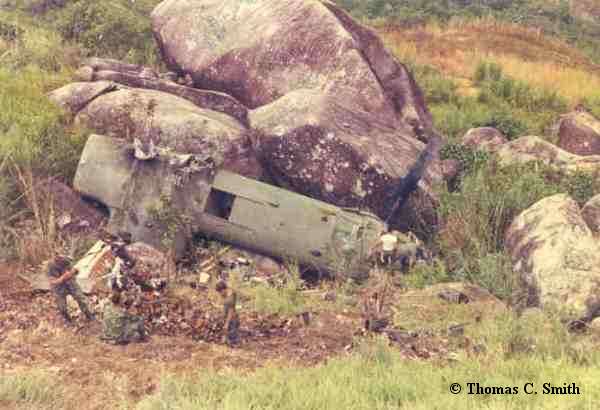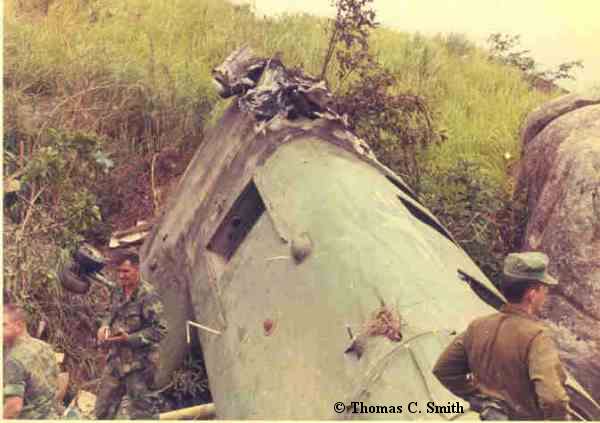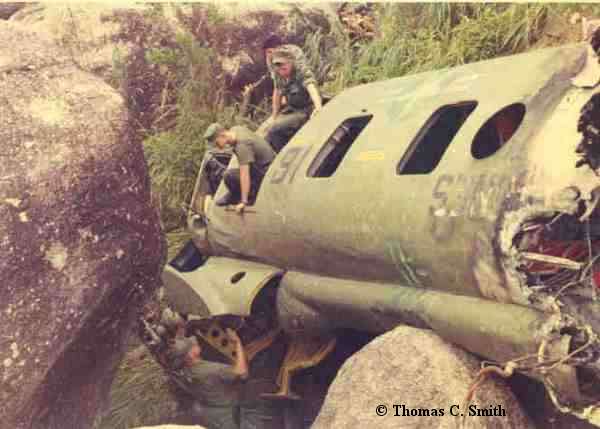How to Get Shot Up and Not Know About It
By Daryl D. Riersgard, 1stLt. USMCR (Vet)
This is an account from 34 years ago. As the
title suggests it is not easy to get a personal wound in combat and not
realize it for 45 minutes. This is my best attempt at reassembling
the facts of the incident from 27 October 1970.
There were few aircraft flyable this date, possibly
only three being Bureau #s 154838 (YK-18??),
154027 and 154815. The last two were assigned the medevac mission
for the day with Bureau # 154027 flown by 1stLt. Steve
"Injun" Kux and Maj. N. R. Van Leeuwen,
and Bureau # 154815 piloted by 1stLt. Peter T. "Pete"
Baron and 1stLt. Larry J. "Harvey Wallbanger"
Thompson. The weather conditions this morning gave us low ceilings
and light rain. Forced to fly low, Lts. Baron and Thompson encountered
intense enemy fire and received numerous hits which resulted in a forced
landing before reaching Marble Mountain Air Facility. Their crew
was picked up by Lt. Kux and Maj. Van Leeuwen and delivered to Marble Mountain.
This story has to do with a replacement
crew for the medevac mission which was assembled quickly after the battle
damage sustained by Bureau # 154815 and consisted of 1stLt.
Gary "Bofus" Denton, the pilot, me, Daryl
Riersgard as his copilot and Cpl. Gary Radliff
the crew chief. I don't recall the names of the aerial gunners
or the corpsman. Our crew was assembled, briefed and airborne by
mid-morning. Due to the number of medical evacuations required we
did not join up with Lt. Kux's aircraft, but rather each individual aircraft
were sent to various locations by DaNang DASC. We each had gun ship
support.
Our first medevac mission included
a routine pickup approximately 25 miles south of Marble Mountain.
Our second assignment was trickier as it was atop Hill-270 South.
For those that recall this zone, there was never enough room to place all
three wheels on the ground so we tended to one or two wheel landings while
maintaining a partial hover.
As we approached this mountain
top zone, Lt. Denton was at the controls. Our approach was flatter
than normal as we had to fly in under the base of the clouds. Our
approach was from the north west side of the landing zone, and was normal
until around 200 to 300 feet above the zone. Our approach went from
normal to catastrophic in just an instant. I recall a loud noise,
perhaps an explosion, followed immediately by a rotor system intermesh.
I have a clear memory of seeing a rotor blade fly off on the left side
(usually a bad sign). It looked like a boomerang flying out and away
from the helicopter. In that brief instant we went from a perfectly
good helicopter to a 26,000 pound rock. Our approach path was such
that we overshot the zone and crashed on the south east slope of the hill.
I estimate we impacted the ground about 50 yards past the zone where the
Marines were positioned.
I remember the ground coming
up fast, but I don't recall the actual impact. I was knocked out
when we hit and based upon the crescent shaped piece of skin missing from
under my chin, I assume the bullet bouncer came up while my head was coming
down the upper cut put me to sleep for a few seconds.
I do recall waking up as the
helo was doing a wild roller coaster ride down the mountain. The
distance from the first impact to the final resting place was less than
100 yards. This wild ride would have lasted a lot longer except for
some very large boulders that stopped us in our tracks. I believe
I was knocked out a second time when we hit the boulders. When I
woke up I recall the aircraft being on its left side. My first instinct
was to get out through the normal crew's entrance. I decided that
wasn't such a good idea when I saw flames in the cabin section. I
elected to depart the wreckage through my emergency side window, popped
the handle and the window section fell away. My exit route was clear
now as I was looking down into a five foot gap in the rocks. I released
the side panel of the armored seat, released the seat belt and shoulder
harness and rolled out. This would have been a cool exit except that
I forgot to release my helmet radio pig tail connection. That mistake
gave me a good head jolt before I hit the ground.
When I crawled out of the rocky
hole, I came around the nose section of the aircraft and had my first good
look at the mess. A good portion of the helo was engulfed in flames.
I saw the Corpsman crawl out of crew's door, on what was now the top part
of the wreckage. Within a few seconds others followed. It was
an orderly process as we assisted each other to safety. I don't recall
the total on board in excess of the five crew members , but I believe we
still had the routine evacuees on board from the previous pickup site.
By the time we had everyone out
of the wreckage I recall a few rounds cooking off from the heat.
Now that the cabin was evacuated we turned our attention to getting the
pilot out. For those who recall, Gary "Bofus" Denton was a big guy.
My first impression was that Gary had died in the crash. The top
portion of the cockpit had caved in around his head. There was also
a large quantity of red fluid on top of us. My first thought was
that it must be blood, but later it was apparent that we both had gotten
a hot bath of hydraulic fluid. He was still unconscious and very
difficult to pull up and out of his rescue side window that was now the
top of the wreckage pile. As three of us were lifting him out he
began to regain consciousness. Apparently there was not enough fuel
spilling to sustain the fire since the helicopter was not totally consumed
by fire.
While all this was going on there
was a decent fire fight overhead. The Marines on the hill top were
firing at the enemy positions who most likely shot us down. Our next
challenge was to crawl up a very wet mountainside to the relative safety
of the Marines on Hill-270S. Some of the men could help themselves,
others needed assistance getting to the top. It was tempting to grab
an M-16 and join the fire fight except we all had our hands full.
It seemed like we would take two steps up and slide back one on the steep,
wet slope. As we approached the top of the mountain, ground Marines
were coming down to meet us and to assist us the remainder of the way up.
While all this was going on,
our Huey gun cover made a memorable move. That crew flew to the nearest
fire support base and dropped off the entire crew and machine guns leaving
only the pilot and the copilot aboard. This lightened their aircraft
to make them capable of extracting the most seriously injured from our
crash or wounded of the grunts. That crew was back in the zone within
a matter of minutes and evacuated the most critical. The rest of
us had to wait for Steve Kux to finish the rescue. At the time of
our crash he was refueling at Marble Mountain and then broke the air speed
red line limitation getting back to us.
Now to the title of this story
. . . .
I recall after helping lift some
of the evacuees into the Huey, I noticed that my left boot was covered
with blood. The assumption was the blood belonged to one of those
Marines we had just loaded into the Huey. I wiped the blood off on
the back of my flight suit pant leg. I then sat down to recount this
wild adventure. After a few minutes, now nearly 45 minutes after
the crash, I looked down and noticed my boot was again covered with
blood. When I pulled up the left leg of the flight suit I saw that
I had a bullet hole through my calf and out my shin. It was a minor
wound, but it seemed odd that I had no recollection thanks to all the other
excitement going on.
Steve Kux landed a short time
later and flew the remainder of us to the 95th Evacuation Hospital for
medical assistance.
I flew back to the crash site
a few days later, as a passenger, and found the copilots emergency hatch.
The Plexiglas was missing from the frame; however, it was easy to identify
three different bullet holes in the frame of the emergency escape window.

Recover crew salvaging radios and other reusable parts
from the crash site a
day or so later.

Capt. Art Blades, lower right, examines YK-18.

Wonder how many more times YK-18, would have rolled
over if the huge rocks
hadn't been there?
Back Browser or Home
.


